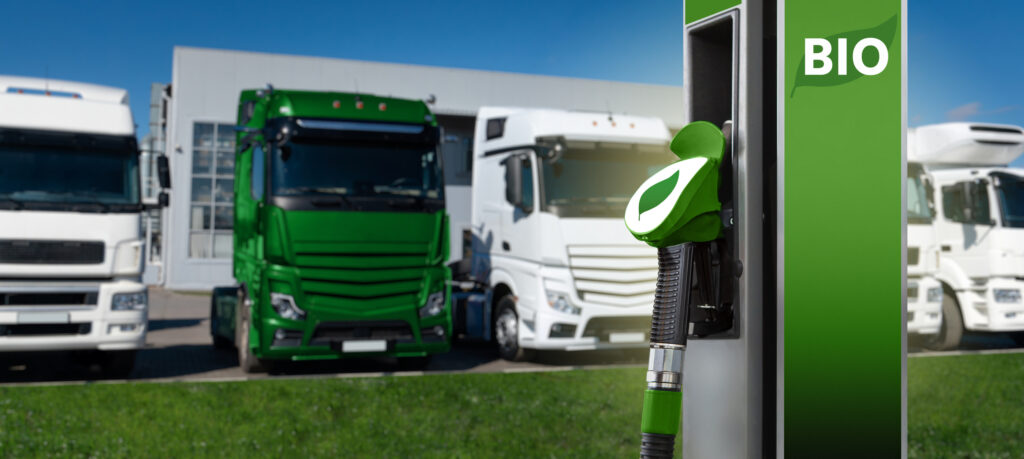With significantly lower CO2 emissions, biofuels such as biomethane and hydrogen are being recognised as having the potential to replace fossil fuels in the transportation industries and the UK government has banned sales of diesel trucks weighing up to 26 tonnes from 2035 and heavier vehicles from 2040. The need to find alternative, low carbon fuels has never been more pressing.
In October 2023, the then Conservative government announced £200 million funding to help decarbonise freight vehicles in the UK through the roll out of 370 new zero-emission trucks and funding for a competition between small and medium-sized companies to boost innovation and green technologies in freight.

In a recent industry interview, Philip Fjeld, CEO of ReFuels NV, one of Europe’s leading suppliers of biomethane stated that:
“HGVs alone account for 5% of UK carbon emissions, making their decarbonisation one of the single most important things the UK can do to meet out net zero ambitions”
This makes stark reading and emphasises the importance of biofuels in the race to be greener. As such, biofuels are set to become increasingly popular over the next few years as manufacturers try to decrease carbon dioxide emissions and meet government legislation.
But what are biofuels and which biofuels are relevant to the HGVs? This article helps to explain.
Biofuels for the future
Already popular in Scandinavia, North and South America, biofuels are becoming increasingly popular in the UK with trials underway within the transport sector, with industry leaders pushing for more HGVs that run on biofuel alternatives. There is a great deal of investment in this research and development sector.
Biofuels generally produce far lower lifetime CO2 emissions than fossil fuels. They improve vehicle performance and have a better fuel economy than conventional fuels. Some biofuels are made from plants, others from food waste. They are cheaper than petrol and diesel and are a renewable energy source.
Furthermore, biofuels should remain cheaper than petrol and diesel as they are easier to produce.
One of the most important benefits for biofuels for HGVs is that they actually improve air quality – since being introduced to the UK in 2021, E10 fuel, a biofuel blend, has been seen to reduce CO2 emissions by 78.45% compared with petroleum diesel.
Biofuels are clearly a significant player in the challenge to decarbonise the HGV industry.
But what types of biofuel are available?
There are a number of different biofuels that are relatively newly available or are being developed. Those that are particularly relevant to the HGV sector are bio-CNG, bio-LNG and also hydrogen fuel. Let’s take a look at each of these now.
Bio-CNG
What is Bio-CNG?
Bio-CNG is a renewable fuel produced from sustainable feedstocks, using recovered waste, including food waste and manure from the agricultural industry. It has the potential to deliver a net reduction of up to 90% in CO2 emissions.
What does ‘bio-CNG’ mean?
Bio-CNG (which stands for compressed natural gas) is the lowest carbon, most cost-effective alternative fuel to diesel available to HGVs today. Along with offering a huge reduction in CO2 emissions it provides a 40% lifetime fuels cost saving compared to diesel.
How popular is Bio-CNG?
The HGV sector is witnessing a rapidly growing demand for bio-CNG from fleet operators and ReFuels is currently expanding its network of fuelling stations, with development underway in Aylesford (SE England) and Bangor (N Wales).
A number of other firms are expanding their networks of bio-CNG stations across the UK. Gasrec, a company part-owned by BP has a network of 10 biomethane stations at present, which power approximately 40% of the UKs gas-powered HGVs.
Bio-CNG is compressed at high pressure and stored in tanks on the HGV. These tanks are large and therefore take up more space on vehicles, reducing load capacity.
Specialist companies, truck manufacturers and haulage firms are continuing to invest in biofuel technology and infrastructure to support this high-growth sector. Bio-CNG will remain a key part of the alternative HGV fuel scene for many years to come.
Companies such as ReFuels, based in the Netherlands and London have been working since 2014 to decarbonise commercial transport fleets across Europe and are a 40% owner of CNG Fuels. Their mission states that they aim to:
“deliver emission reductions, cost savings, increased efficiencies, noise reduction, long-term sustainability, and a safe service to companies running commercial transport fleets through our renewable biomethane product offering. Together, we can join the road to recovery”
ReFuels’ vision sees them as the catalyst for commercial transport fleets to be powered by 100% renewable fuel and are developing a network of public access CNG stations – they currently have 16 stations in the UK alone, helping businesses to meet their net zero commitments and have a target of 30-40 stations across the UK by the end of 2026.
Bio-LNG
What is Bio-LNG?
Bio-LNG is another biomethane fuel that is created by processing organic waste flows including household waste, manure and sewage sludge, which are waste or by-products from other sectors. The process of anaerobic digestion emits a bio-gas which comprises methane and carbon dioxide.
The methane is separated from the carbon dioxide and is liquified. This creates a very dense liquid that is suitable for use in the HGV and maritime industries and is practically carbon-neutral.
What are the Advantages of Bio-LNG?
Benefits of using bio-LNG reported by HGV drivers include reduced engine noise, whilst further environmental benefits include significantly lower particulate matter emissions than diesel. Vehicles running on bio-LNG also have a much longer range than those running on bio-CNG.
Bio-LNG is cooled down to a temperature of -161C to -164C and has a far smaller volume than bio-CNG. This means that the storage tanks are considerably smaller for bio-LNG than bio-CNG (the volume of 1kg of bio-LNG is 1/600th of 1kg of bio-CNG whilst the energy content of 1 litre of bio-LNG is equal to 3 litres of bio-CNG). This does give advantages concerning the storage and transportation of the fuel. One major drawback is the cost of storing bio-LNG as it needs to be kept cooled, which requires highly sophisticated and expensive equipment.
Bio-CNG vs Bio-LNG
Ultimately, bio-CNG is widely considered to be a more suitable biofuel for HGVs for general urban driving because it requires far simpler and cheaper storage conditions than bio-LNG and despite the restrictions its use places on load capacity, bio-CNG is more cost effective for HGV manufacturers and hauliers to incorporate into vehicle design and adaptations.
HGV hydrogen
The trucking industry is facing its biggest change in history. By 2040, all HGVs will need to be zero-emission; but right now, 96% run on diesel.
Source: hvs.co.uk
In recent years, numerous trials of hydrogen HGVs have got underway. Scottish HGV manufacturers HVS decided that instead of adapting existing vehicles, they would develop their own. As mentioned earlier, their hydrogen powered HGVs have a range of 600km, and a refuelling time of only 15-20 minutes. Further information can be found here.
One project that received a share of the £200 million Government funding in 2023 was for Freight and Hydrogen Aggregated Logistics (HyHAUL) by Protium, to roll out the introduction of hydrogen fuel cell trucks. This project has been working to consolidate the long-distance hydrogen HGV value chain including the transportation of hydrogen, the refuelling infrastructure and multiple hydrogen fuel cell HGV manufacturers (source: Innovation News Network).
Hydrogen is stored under high pressure in tanks that are designed to withstand impact and the gas is converted into electricity, using a fuel cell, to drive the wheels. As an alternative to standard electric power, hydrogen requires a far smaller battery and has a much shorter charge time, however hydrogen is expensive to make and is less efficient than plugging a battery in to a charging point.
Hydrogen may have a role in decarbonising some areas of the transport sector, including HGVs and manufacturers are investing in research and development of hydrogen-powered vehicles, but the sector needs much more investment and at present it is not as widely favoured as other biofuels.
Frequently Asked Questions
What are biofuels?
Biofuels are alternatives to diesel and petrol that are made from renewable sources. Types of biofuel currently available include Bio-CNG, Bio-LNG and Hydrogen.
Can I use biofuels in my HGV?
If you have a diesel or petrol engine you will need to convert your vehicle to run on biofuels.
When are diesel HGVs being phased out?
The UK Government has pledged that no new non-zero-emission HGVs will be sold by 2040. Sales of smaller non-zero-emission HGVs (weighing under 26 tonnes) will be phased out by 2035. Further information is available here.



